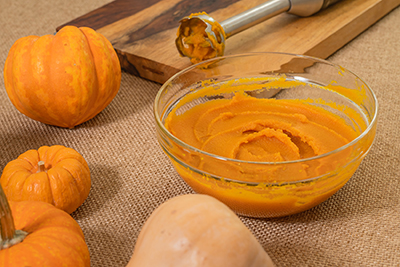Pumpkin Perks: From Seed to Spoon
As we approach midautumn, pumpkins are plentiful and make fun, spooky Halloween decorations, but did you know that these orange beauties can be used for so much more than decoration? With the many ways to cook and eat pumpkins, let’s make the most of this special fall fruit and enjoy all its health benefits.
Can I Eat Any Pumpkin?
Yes! All pumpkins are edible, and all parts of the pumpkin are edible. That being said, different varieties of pumpkins have different flavour and nutrient profiles, and the same goes for different parts of the same pumpkin. What a versatile fruit!
The smaller pumpkins tend to be more flavourful than the larger ones and are great for pies. The larger ones are commonly used for pumpkin carving, but both can be eaten and prepared in different ways.
The Pumpkin Flesh
The firm, edible part of the pumpkin that is located between the skin and the seeds is high in vitamins A, B, C, E, and K as well as in antioxidants like quercetin and minerals like magnesium.[1]
The Pulp of the Pumpkin
The stringy, fibrous material that surrounds the seeds inside the pumpkin is also high in vitamins and minerals and can be added to soups or smoothies. Pumpkin flesh can be simply enjoyed roasted or can be puréed for various sweet or savoury dishes.
Pumpkin Seeds
Excellent sources of various proteins, healthy fats, and elements like zinc, selenium, magnesium, phosphorus, and potassium, these also taste great roasted or can be shelled and added to various dishes or smoothies.
Pumpkin skin, or the peel, is also edible and nutritious. The peel contains protein; healthy fats; fibre; and minerals like potassium, iron, and magnesium. A great way to enjoy these benefits is to make pumpkin-peel chips in the air fryer or dehydrator.
How Do I Cook a Pumpkin?
You can start by cutting the pumpkin in half and scoop out the pulp and seeds. Don’t forget to save these for later, now that you know they are edible and packed with nutrients. You can then brush the pumpkin flesh with some oil (like olive or coconut oil) and sprinkle with some salt. Place the pumpkin halves flesh-side down on a baking sheet, pierce the skin a couple of times with a fork to let steam escape, and bake at 350 °F (175 °C) for about 45 minutes. Once you have roasted your pumpkin, you can remove (and save) the peel for pumpkin chips or other recipes later.
You can enjoy your freshly roasted pumpkin as is or purée it in a blender to be used in other fun dishes. The purée can also be frozen for use all through winter.
 Why Eat Pumpkins in the Fall?
Why Eat Pumpkins in the Fall?
Fall is a time when the seasons begin to change. The air becomes cooler, less sunlight is available, and cold-and-flu season is just around the corner. The abundance of pumpkins available at this time of year offers some nutritious support to help bolster the immune system. As mentioned earlier, pumpkins are high in nutrients like vitamins A, C, and E; zinc; and selenium, which can help support your immune system to function at its best.
Combining pumpkin with warming spices like cinnamon, nutmeg, ginger, and clove at this time of year is also a tasty way to help warm the body as the air gets cooler. No wonder pumpkin-spice everything is so popular in the fall! Just be sure to watch out for any pumpkin-spice treats that contain more sugar than pumpkin, as this would be decidedly less supportive for your immune system. Pumpkins provide lots of nutrients that are especially helpful in the fall, but they can still be enjoyed year-round thanks to canned pumpkin purée.
Do Pumpkins Have Any Other Health Benefits?
Yes! The healthy fats, antioxidants, vitamins, and minerals found in pumpkin make it helpful in supporting cardiovascular health. Its high-fibre and low-calorie profile make it a helpful food in weight management. It has also been reported to help support healthy blood-sugar regulation and the prevention of diabetes.[2] Pumpkin seeds have also been studied for their use in men’s health and managing symptoms of an enlarged prostate or benign prostate hyperplasia.[3]
Hopefully after reading this, you now have a deeper appreciation for pumpkin. Have a happy pumpkin season!
 Dr. Felicia Assenza, HBSc, ND
Dr. Felicia Assenza, HBSc, ND
A Hamilton-based naturopathic doctor whose goal in every patient visit is to share the knowledge and experiences that she gained on her own journey.
drfeliciaassenzand.com
[1] Batool, M., M.M.A.N. Ranjha, U. Roobab, M.F. Manzoor, U. Farooq, H.R. Nadeem, M. Nadeem, et al. “Nutritional value, phytochemical potential, and therapeutic benefits of pumpkin (Cucurbita sp.).” Plants, Vol. 11, No. 11 (2022): 1394.
[2] Wang, S., A. Lu, L. Zhang, M. Shen, T. Xu, W. Zhan, H. Jin, Y. Zhang, and W. Wang. “Extraction and purification of pumpkin polysaccharides and their hypoglycemic effect.” International Journal of Biological Macromolecules, Vol. 98 (2017): 182–187.
[3] Vahlensieck, W., C. Theurer, E. Pfitzer, B. Patz, N. Banik, and U. Engelmann. “Effects of pumpkin seed in men with lower urinary tract symptoms due to benign prostatic hyperplasia in the one-year, randomized, placebo-controlled GRANU Study.” Urologia Internationalis, Vol. 94, No. 3 (2015): 286–295.

 Stores
Stores